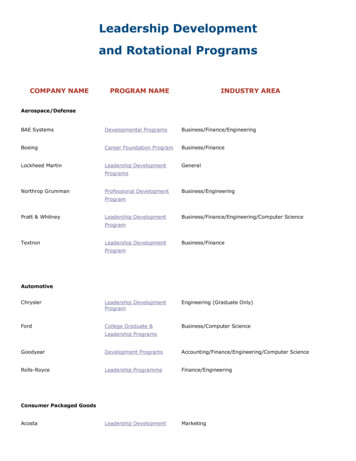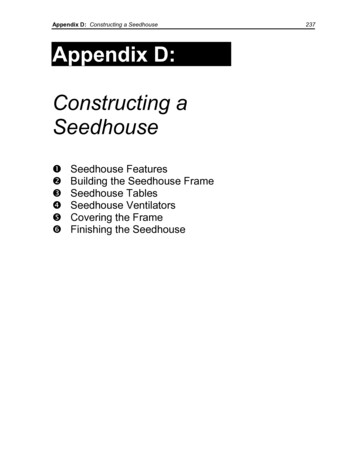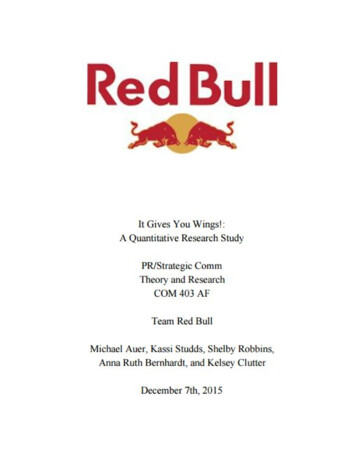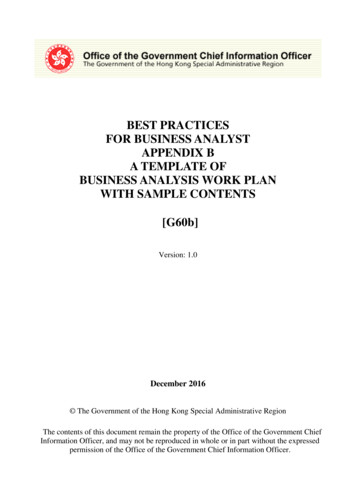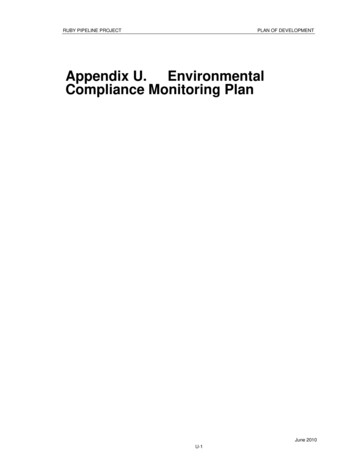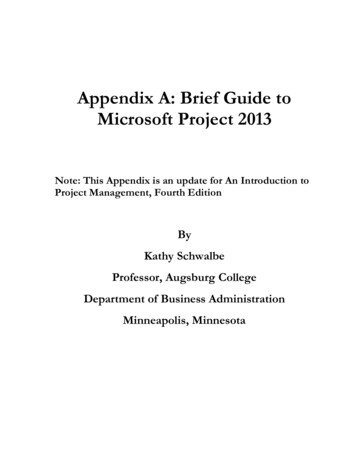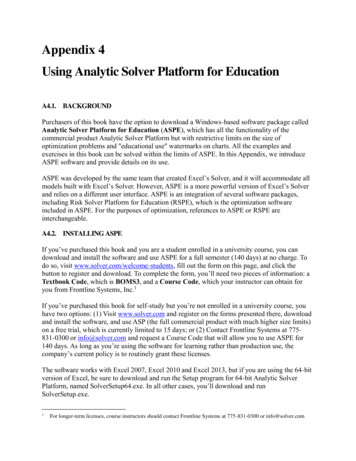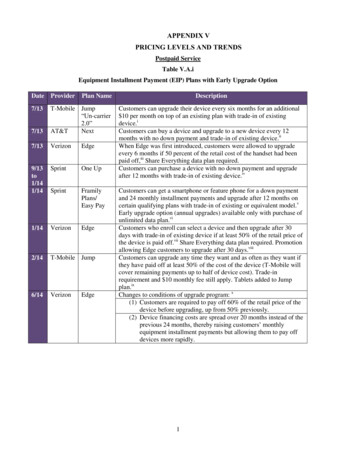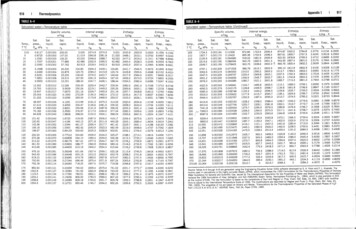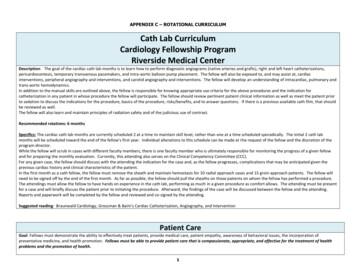
Transcription
APPENDIX C – ROTATIONAL CURRICULUMCATH LAB CURRICULUMCath Lab CurriculumCardiology Fellowship ProgramRiverside Medical CenterDescription: The goal of the cardiac cath lab months is to learn how to perform diagnostic angiograms (native arteries and grafts), right and left heart catheterizations,pericardiocentesis, temporary transvenous pacemakers, and intra-aortic balloon pump placement. The fellow will also be exposed to, and may assist at, cardiacinterventions, peripheral angiography and interventions, and carotid angiography and interventions. The fellow will develop an understanding of intracardiac, pulmonary andtrans-aortic hemodynamics.In addition to the manual skills are outlined above, the fellow is responsible for knowing appropriate use criteria for the above procedures and the indication forcatheterization in any patient in whose procedure the fellow will participate. The fellow should review pertinent patient clinical information as well as meet the patient priorto sedation to discuss the indications for the procedure, basics of the procedure, risks/benefits, and to answer questions. If there is a previous available cath film, that shouldbe reviewed as well.The fellow will also learn and maintain principles of radiation safety and of the judicious use of contrast.Recommended rotations: 6 monthsSpecifics: The cardiac cath lab months are currently scheduled 2 at a time to maintain skill level, rather than one at a time scheduled sporadically. The initial 2 cath labmonths will be scheduled toward the end of the fellow’s first year. Individual alterations to this schedule can be made at the request of the fellow and the discretion of theprogram director.While the fellow will scrub in cases with different faculty members, there is one faculty member who is ultimately responsible for monitoring the progress of a given fellowand for preparing the monthly evaluation. Currently, this attending also serves on the Clinical Competency Committee (CCC).For any given case, the fellow should discuss with the attending the indication for the case and, as the fellow progresses, complications that may be anticipated given theprevious cardiac history and clinical characteristics of the patient.In the first month as a cath fellow, the fellow must remove the sheath and maintain hemostasis for 10 radial approach cases and 15 groin approach patients. The fellow willneed to be signed off by the end of the first month. As far as possible, the fellow should pull the sheaths on those patients on whom the fellow has performed a procedure.The attendings must allow the fellow to have hands on experience in the cath lab, performing as much in a given procedure as comfort allows. The attending must be presentfor a case and will briefly discuss the patient prior to initiating the procedure. Afterward, the findings of the case will be discussed between the fellow and the attending.Reports and paperwork will be completed by the fellow and reviewed and co-signed by the attending.Suggested reading: Braunwald Cardiology, Grossman & Baim's Cardiac Catheterization, Angiography, and InterventionPatient CareGoal: Fellows must demonstrate the ability to effectively treat patients, provide medical care, patient empathy, awareness of behavioral issues, the incorporation ofpreventative medicine, and health promotion. Fellows must be able to provide patient care that is compassionate, appropriate, and effective for the treatment of healthproblems and the promotion of health.1
Reporting Milestones:PC1 – Invasive Cardiovascular TestingPC3 – Acute CareObjectivesFellows are expected to:1. Demonstrate competence in prevention, evaluation and management of the following: Arrhythmias Acute myocardial infarction and other acute ischemic syndromes Cardiomyopathy Cardiovascular evaluation of patients undergoing non-cardiac surgery Congestive heart failure Coronary heart disease Acute coronary syndromes Chronic coronary heart disease Diseases of the aorta Heart disease in pregnancy Hypertension Peripheral vascular disease Pericardial disease Pulmonary hypertension Thromboembolic disorders Valvular heart disease2. Demonstrate competence in the practice of health promotion, disease prevention,diagnosis, care and treatment of patients of each gender, from adolescence to old age,during health and all stages of illness.Teaching MethodEvaluation MethodPGY LevelDidacticsBoard ReviewBedside TeachingClinical Teaching RoundsRole ModelingIndependent LearningEnd of Rotation Evaluation360 Degree EvaluationAmbulatory Clinic EvaluationAnnual PD EvaluationIn-Training ExamDirect ObservationIndirect SupervisionPGY4PGY5PGY6DidacticsBoard ReviewBedside TeachingClinical Teaching RoundsRole ModelingIndependent LearningEnd of Rotation Evaluation360 Degree EvaluationAmbulatory Clinic EvaluationAnnual PD EvaluationIn-Training ExamDirect ObservationIndirect SupervisionPGY4PGY5PGY6End of Rotation Evaluation360 Degree EvaluationAmbulatory Clinic EvaluationAnnual PD EvaluationIn-Training ExamDirect ObservationIndirect SupervisionEnd of Rotation Evaluation360 Degree EvaluationAmbulatory Clinic EvaluationPGY43.Identify life threatening cardiovascular conditions and emergencies and to be able toinitiate prompt therapy.DidacticBoard ReviewBedside TeachingClinical Teaching RoundsRole ModelingIndependent Learning4.Develop a working knowledge of the risk/benefit assessment that must take place priorto performing an invasive cardiac procedure.DidacticBoard ReviewBedside Teaching2PGY4
Clinical Teaching RoundsRole ModelingIndependent Learning5.Participate in the performance of invasive procedures only under the direct supervisionof an attending cardiologist.DidacticBedside TeachingClinical Teaching RoundsRole ModelingIndependent Learning6.Master the development of acute and chronic management plans for patients withcardiovascular diseases.DidacticBoard ReviewBedside TeachingClinical Teaching RoundsRole ModelingIndependent Learning7.Apply evidence-based medicine to develop comprehensive acute and chronicmanagement plans for the full spectrum of cardiovascular diseases.DidacticBoard ReviewBedside TeachingClinical Teaching RoundsRole ModelingIndependent Learning8.Skillfully select and interpret the most appropriate cardiac tests for individual patientsand to expertly apply the results leading to the safest and most optimal care.DidacticBoard ReviewBedside TeachingClinical Teaching RoundsRole ModelingIndependent Learning9.Manage all cardiac patients expertly and should be able to function independently as aconsultant cardiologist.DidacticBoard ReviewBedside TeachingClinical Teaching RoundsRole ModelingIndependent Learning10. Appropriately interpret and apply all data to enhance patient care.DidacticBoard ReviewBedside Teaching3Annual PD EvaluationIn-Training ExamDirect ObservationIndirect SupervisionEnd of Rotation Evaluation360 Degree EvaluationAmbulatory Clinic EvaluationAnnual PD EvaluationIn-Training ExamDirect ObservationIndirect SupervisionEnd of Rotation Evaluation360 Degree EvaluationAmbulatory Clinic EvaluationAnnual PD EvaluationIn-Training ExamDirect ObservationIndirect SupervisionEnd of Rotation Evaluation360 Degree EvaluationAmbulatory Clinic EvaluationAnnual PD EvaluationIn-Training ExamDirect ObservationIndirect SupervisionEnd of Rotation Evaluation360 Degree EvaluationAmbulatory Clinic EvaluationAnnual PD EvaluationIn-Training ExamDirect ObservationIndirect SupervisionEnd of Rotation Evaluation360 Degree EvaluationAmbulatory Clinic EvaluationAnnual PD EvaluationIn-Training ExamDirect ObservationIndirect SupervisionEnd of Rotation Evaluation360 Degree EvaluationAmbulatory Clinic EvaluationPGY4PGY5PGY6PGY6PGY6PGY6
Clinical Teaching RoundsRole ModelingIndependent LearningAnnual PD EvaluationIn-Training ExamDirect ObservationIndirect SupervisionMedical KnowledgeGoal: Fellows are expected to demonstrate and apply knowledge of accepted standards of clinical cardiology, remain current with new developments in cardiology, andparticipate in life-ling learning activities, including research and review of the literature. Fellows must demonstrate knowledge of established and evolving biomedical, clinical,epidemiological and social-behavioral sciences, as well as the application of this knowledge to the care of patients with cardiovascular diseases.Reporting Milestones:MK1- Cardiovascular TestingMK2- Critical Thinking for Diagnosis and TherapyObjectivesFellows are expected to:1. Demonstrate knowledge of the following content areas:Basic science, including: Cardiovascular anatomy Cardiovascular metabolism Cardiovascular pathology Cardiovascular pharmacology, including drug metabolism, adverse effects,indications, the effects on aging, relative costs of therapy, and the effects ofnon-cardiovascular function Cardiovascular physiologyPrimary and secondary prevention of cardiovascular disease, including: Biostatistics Clinical epidemiology Cardiac rehabilitation Current and emerging risk factors; and cerebrovascular diseaseEvaluation and management of patients: Adult congenital heart disease Cardiac trauma Cardiac tumors cerebrovascular disease Geriatric cardiology2. Demonstrate the critical knowledge base that will permit them to function as acompetent well-rounded cardiologists in the following areas: Coronary artery disease Myocardial diseases4Teaching MethodEvaluation MethodPGY LevelDidacticsBoard ReviewBedside TeachingClinical Teaching RoundsRole ModelingIndependent LearningEnd of Rotation Evaluation360 Degree EvaluationAmbulatory Clinic EvaluationAnnual PD EvaluationIn-Training ExamDirect ObservationIndirect SupervisionPGY4PGY5PGY6DidacticBoard ReviewBedside TeachingClinical Teaching RoundsEnd of Rotation Evaluation360 Degree EvaluationAmbulatory Clinic EvaluationAnnual PD EvaluationPGY4
Heart failure Congenital heart disease Valvular heart disease Peripheral vascular disease Diseases of the aorta Cardiovascular prevention Hypertension Pericardial diseases Cardiac dysrhythmias Clinical electrophysiology Cardiothoracic surgery Pulmonary hypertensionDemonstrate knowledge of the scientific method of problem solving and evidencebased decision making.Role ModelingIndependent LearningIn-Training ExamDirect ObservationIndirect SupervisionDidacticsBoard ReviewBedside TeachingClinical Teaching RoundsRole ModelingIndependent LearningEnd of Rotation Evaluation360 Degree EvaluationAmbulatory Clinic EvaluationAnnual PD EvaluationIn-Training ExamDirect ObservationIndirect SupervisionPGY4PGY5PGY64.Demonstrate a knowledge of indications, contraindications, limitations, complications,techniques, and interpretation of results of those diagnostic and therapeuticprocedures integral to the discipline, including the appropriate indications for and useof screening tests/procedures.DidacticsBoard ReviewBedside TeachingClinical Teaching RoundsRole ModelingIndependent LearningEnd of Rotation Evaluation360 Degree EvaluationAmbulatory Clinic EvaluationAnnual PD EvaluationIn-Training ExamDirect ObservationIndirect SupervisionPGY4PGY5PGY65.Identify the risks benefits and indications of various invasive and non-invasive cardiacprocedures and tests.DidacticBoard ReviewBedside TeachingClinical Teaching RoundsRole ModelingIndependent LearningEnd of Rotation Evaluation360 Degree EvaluationAmbulatory Clinic EvaluationAnnual PD EvaluationIn-Training ExamDirect ObservationIndirect SupervisionPGY4PGY56.Recite the basic literature related to cardiovascular testing and procedures.DidacticBoard ReviewBedside TeachingClinical Teaching RoundsRole ModelingIndependent LearningEnd of Rotation Evaluation360 Degree EvaluationAmbulatory Clinic EvaluationAnnual PD EvaluationIn-Training ExamDirect ObservationPGY43.5
7.Develop a reading program that will build the foundation of basic cardiology knowledgenecessary to become a competent clinical cardiologist.DidacticBoard ReviewBedside TeachingClinical Teaching RoundsRole ModelingIndependent Learning8.Demonstrate an understanding of the pathophysiologic basics of commoncardiovascular diseases and use this knowledge to help guide clinical managementdecisions.DidacticBoard ReviewBedside TeachingClinical Teaching RoundsRole ModelingIndependent Learning9.Demonstrate how best to utilize cardiac procedures in the care of patients.DidacticBoard ReviewBedside TeachingClinical Teaching RoundsRole ModelingIndependent Learning10. Critically review and be well-versed in all aspects of cardiology literature and apply it inan evidenced-based manner to the care of patients.DidacticBoard ReviewBedside TeachingClinical Teaching RoundsRole ModelingIndependent Learning11. Teach medical students, residents, and junior cardiology fellows on clinical services,laboratory and non-laboratory setting and actively participate in conferences.DidacticBoard ReviewBedside TeachingClinical Teaching RoundsRole ModelingIndependent LearningPractice-based Learning and Improvement6Indirect SupervisionEnd of Rotation Evaluation360 Degree EvaluationAmbulatory Clinic EvaluationAnnual PD EvaluationIn-Training ExamDirect ObservationIndirect SupervisionEnd of Rotation Evaluation360 Degree EvaluationAmbulatory Clinic EvaluationAnnual PD EvaluationIn-Training ExamDirect ObservationIndirect SupervisionEnd of Rotation Evaluation360 Degree EvaluationAmbulatory Clinic EvaluationAnnual PD EvaluationIn-Training ExamDirect ObservationIndirect SupervisionEnd of Rotation Evaluation360 Degree EvaluationAmbulatory Clinic EvaluationAnnual PD EvaluationIn-Training ExamDirect ObservationIndirect SupervisionEnd of Rotation Evaluation360 Degree EvaluationAmbulatory Clinic EvaluationAnnual PD EvaluationIn-Training ExamDirect ObservationIndirect SupervisionPGY4PGY5PGY5PGY4PGY5PGY6PGY6
Goal: Fellows must demonstrate the ability to investigate and evaluate their care of patients, to appraise and assimilate scientific evidence, and to continuouslyimprove patient care based on constant self- evaluation and life-long learning.Reporting Milestones:PBLI1- Evidence-Based and Informed PracticePBLI2- Reflective Practice and Commitment to Personal GrowthPBLI3- Professional Behavior and Ethical PrinciplesObjectives:Teaching MethodEvaluation MethodPGY LevelFellows are expected to:1.Identify strengths, deficiencies, and limits in one’s knowledge and expertiseBoard ReviewBedside TeachingClinical Teaching RoundsRole ModelingIndependent Learning2.Set learning and improvement goalsBoard ReviewBedside TeachingClinical Teaching RoundsRole ModelingIndependent Learning3.Identify and perform appropriate learning activitiesBoard ReviewBedside TeachingClinical Teaching RoundsRole ModelingIndependent Learning4.Systematically analyze practice, using quality improvement methods, and implementchanges with the goal of practice improvement.Board ReviewBedside TeachingClinical Teaching RoundsRole ModelingIndependent Learning5.Incorporate formative evaluation feedback into daily practiceBoard ReviewBedside TeachingClinical Teaching RoundsRole ModelingIndependent Learning7End of Rotation Evaluation360 Degree EvaluationAmbulatory Clinic EvaluationAnnual PD EvaluationIn-Training ExamDirect ObservationIndirect SupervisionEnd of Rotation Evaluation360 Degree EvaluationAmbulatory Clinic EvaluationAnnual PD EvaluationIn-Training ExamDirect ObservationIndirect SupervisionEnd of Rotation Evaluation360 Degree EvaluationAmbulatory Clinic EvaluationAnnual PD EvaluationIn-Training ExamDirect ObservationIndirect SupervisionEnd of Rotation Evaluation360 Degree EvaluationAmbulatory Clinic EvaluationAnnual PD EvaluationIn-Training ExamDirect ObservationIndirect SupervisionEnd of Rotation Evaluation360 Degree EvaluationAmbulatory Clinic EvaluationAnnual PD EvaluationIn-Training ExamDirect ObservationIndirect 4PGY5PGY6PGY4PGY5PGY6
6.Locate, appraise, and assimilate evidence from scientific studies related to theirpatients’ health problems.Board ReviewBedside TeachingClinical Teaching RoundsRole ModelingIndependent Learning7.Use information technology to optimize learningBoard ReviewBedside TeachingClinical Teaching RoundsRole ModelingIndependent LearningComputer Module8.Participate in the education of patients, families, students, fellows and other healthprofessionalsDidacticsBoard ReviewBedside TeachingClinical Teaching RoundsRole ModelingIndependent Learning9.Obtain procedure-specific informed consent by competently educating patients aboutrationale, technique, and complications of procedures.Board ReviewBedside TeachingClinical Teaching RoundsRole ModelingIndependent LearningEnd of Rotation Evaluation360 Degree EvaluationAmbulatory Clinic EvaluationAnnual PD EvaluationIn-Training ExamDirect ObservationIndirect SupervisionEnd of Rotation Evaluation360 Degree EvaluationAmbulatory Clinic EvaluationAnnual PD EvaluationIn-Training ExamDirect ObservationIndirect SupervisionEnd of Rotation Evaluation360 Degree EvaluationAmbulatory Clinic EvaluationAnnual PD EvaluationIn-Training ExamDirect ObservationIndirect SupervisionEnd of Rotation Evaluation360 Degree EvaluationAmbulatory Clinic EvaluationAnnual PD EvaluationIn-Training ExamDirect ObservationIndirect 4PGY5PGY6Interpersonal and Communication SkillsGoal: Fellows must demonstrate interpersonal and communication skills that result in the effective exchange of information and collaboration with patients,their families, and health professionals.Reporting Milestones:ICS1- Patient and Family-Centered CommunicationICS2- Interprofessional and Team CommunicationICS3- Communication within Health Care SystemObjectives:Teaching MethodEvaluation MethodPGY LevelFellows are expected to:1.Communicate effectively with patients, families, and the public, as appropriate, across abroad range of socioeconomic and cultural backgrounds; including the risks and benefitsof various cardiac procedures.8Bedside TeachingClinical Teaching RoundsRole ModelingIndependent LearningEnd of Rotation Evaluation360 Degree EvaluationAmbulatory Clinic EvaluationAnnual PD EvaluationPGY4PGY5PGY6
2.Communicate effectively with physicians, other health professionals, and health relatedagencies.Bedside TeachingClinical Teaching RoundsRole ModelingIndependent Learning3.Work effectively as a member or leader of a health care team or other professionalgroup.Board ReviewBedside TeachingClinical Teaching RoundsRole ModelingIndependent Learning4.Act in a consultative role to other physicians and health professionals.Bedside TeachingClinical Teaching RoundsRole ModelingIndependent Learning5.Maintain comprehensive, timely, and legible medical records.Role Modeling6.Contribute to patient management discussion on round in conjunction with the staffphysician.DidacticBoard ReviewBedside TeachingClinical Teaching RoundsRole ModelingIndependent Learning7.Properly document procedure findings and document a thorough and accurate reporton any procedure performed.Bedside TeachingClinical Teaching RoundsRole ModelingIndependent Learning9In-Training ExamDirect ObservationIndirect SupervisionEnd of Rotation Evaluation360 Degree EvaluationAmbulatory Clinic EvaluationAnnual PD EvaluationIn-Training ExamDirect ObservationIndirect SupervisionEnd of Rotation Evaluation360 Degree EvaluationAmbulatory Clinic EvaluationAnnual PD EvaluationIn-Training ExamDirect ObservationIndirect SupervisionEnd of Rotation Evaluation360 Degree EvaluationAmbulatory Clinic EvaluationAnnual PD EvaluationIn-Training ExamDirect ObservationIndirect SupervisionEnd of Rotation Evaluation360 Degree EvaluationAmbulatory Clinic EvaluationAnnual PD EvaluationIn-Training ExamDirect ObservationIndirect SupervisionEnd of Rotation Evaluation360 Degree EvaluationAmbulatory Clinic EvaluationAnnual PD EvaluationIn-Training ExamDirect ObservationIndirect SupervisionEnd of Rotation Evaluation360 Degree EvaluationAmbulatory Clinic EvaluationAnnual PD EvaluationIn-Training ExamDirect ObservationIndirect 4PGY5PGY6PGY4PGY4
8.Introduce first year fellows to the program and to assist with bedside procedures suchas: PA catheter placement temporary pacemaker placement transthoracic echocardiographyDidacticBedside TeachingClinical Teaching RoundsRole ModelingIndependent Learning9.Demonstrate improved written and verbal communication skills relative to directpatient care reporting.Bedside TeachingClinical Teaching RoundsRole ModelingIndependent Learning10. Write complete accurate, and informative consults as well as detailed and accurateprocedure reports.DidacticBoard ReviewBedside TeachingClinical Teaching RoundsRole ModelingIndependent LearningEnd of Rotation Evaluation360 Degree EvaluationAmbulatory Clinic EvaluationAnnual PD EvaluationIn-Training ExamDirect ObservationIndirect SupervisionEnd of Rotation Evaluation360 Degree EvaluationAmbulatory Clinic EvaluationAnnual PD EvaluationIn-Training ExamDirect ObservationIndirect SupervisionEnd of Rotation Evaluation360 Degree EvaluationAmbulatory Clinic EvaluationAnnual PD EvaluationIn-Training ExamDirect ObservationIndirect SupervisionPGY5PGY5PGY6ProfessionalismGoal: Fellows must demonstrate a commitment to carrying out professional responsibilities and an adherence to ethical principles.Reporting Milestones:PROF1- AccountabilityPROF2- Self-Awareness and Well-BeingObjectives:Fellows are expected to:Teaching MethodEvaluation MethodPGY LevelEnd of Rotation Evaluation360 Degree EvaluationAmbulatory Clinic EvaluationAnnual PD EvaluationIn-Training ExamDirect ObservationIndirect SupervisionEnd of Rotation Evaluation360 Degree EvaluationAmbulatory Clinic EvaluationPGY4PGY5PGY61.Demonstrate compassion, integrity, and respect for othersBedside TeachingClinical Teaching RoundsRole Modeling2.Demonstrate responsiveness to patient needs that supersedes self-interestBedside TeachingClinical Teaching RoundsRole Modeling10PGY4PGY5PGY6
3.Demonstrate respect for patient privacy and autonomy.Bedside TeachingClinical Teaching RoundsRole Modeling4.Demonstrate accountability to patients, society and the profession.Bedside TeachingClinical Teaching RoundsRole Modeling5.Demonstrate sensitivity and responsiveness to a diverse patient population, includingbut not limited to diversity in gender, age, culture, race, religion, disabilities, and sexualorientation.Clinical Teaching RoundsRole Modeling6.Demonstrate high standards of ethical behavior, including maintaining appropriateprofessional boundaries and relationships with other physicians and other health careteam members, and avoiding conflicts of interest.Bedside TeachingClinical Teaching RoundsRole Modeling7.Function as team leader for the clinical cardiovascular services under the direction ofthe assigned staff physician.DidacticBoard ReviewBedside TeachingClinical Teaching RoundsRole ModelingIndependent LearningAnnual PD EvaluationIn-Training ExamDirect ObservationIndirect SupervisionEnd of Rotation Evaluation360 Degree EvaluationAmbulatory Clinic EvaluationAnnual PD EvaluationIn-Training ExamDirect ObservationIndirect SupervisionEnd of Rotation Evaluation360 Degree EvaluationAmbulatory Clinic EvaluationAnnual PD EvaluationIn-Training ExamDirect ObservationIndirect SupervisionEnd of Rotation Evaluation360 Degree EvaluationAmbulatory Clinic EvaluationAnnual PD EvaluationIn-Training ExamDirect ObservationIndirect SupervisionEnd of Rotation Evaluation360 Degree EvaluationAmbulatory Clinic EvaluationAnnual PD EvaluationIn-Training ExamDirect ObservationIndirect SupervisionEnd of Rotation Evaluation360 Degree EvaluationAmbulatory Clinic EvaluationAnnual PD EvaluationIn-Training ExamDirect ObservationIndirect 4PGY5PGY6PGY6System-Based PracticeGoal: Fellows must demonstrate an awareness of and responsiveness to the larger context and system of healthcare, as well as the ability to call effectively onother resources in the system to provide optimal health care.11
Reporting Milestones:SBP1- Patient Safety and Quality ImprovementSBP2- System Navigation for Patient-Centered CareSBP3- Physician Role in Health Care SystemObjectives:Fellows are expected to:Teaching MethodEvaluation MethodPGY LevelEnd of Rotation Evaluation360 Degree EvaluationAmbulatory Clinic EvaluationAnnual PD EvaluationIn-Training ExamDirect ObservationIndirect SupervisionEnd of Rotation Evaluation360 Degree EvaluationAmbulatory Clinic EvaluationAnnual PD EvaluationIn-Training ExamDirect ObservationIndirect SupervisionEnd of Rotation Evaluation360 Degree EvaluationAmbulatory Clinic EvaluationAnnual PD EvaluationIn-Training ExamDirect ObservationIndirect SupervisionEnd of Rotation Evaluation360 Degree EvaluationAmbulatory Clinic EvaluationAnnual PD EvaluationIn-Training ExamDirect ObservationIndirect SupervisionEnd of Rotation Evaluation360 Degree EvaluationAmbulatory Clinic EvaluationAnnual PD EvaluationIn-Training ExamDirect ObservationIndirect SupervisionEnd of Rotation Evaluation360 Degree EvaluationAmbulatory Clinic EvaluationAnnual PD EvaluationPGY4PGY5PGY61.Work effectively in various health care delivery setting and systems relevant to theirclinical specialty.DidacticBedside TeachingClinical Teaching RoundsRole ModelingIndependent Learning2.Coordinate patient care within the health care system relevant to their clinical specialty.DidacticBedside TeachingClinical Teaching RoundsRole Modeling3.Incorporate considerations of cost awareness and risk-benefit analysis in patient and/orpopulation- based care as appropriate.DidacticBedside TeachingClinical Teaching RoundsRole ModelingIndependent Learning4.Advocate for quality patient care and optimal patient care systems.Bedside TeachingClinical Teaching RoundsRole ModelingIndependent Learning5.Work in interprofessional teams to enhance patient safety and improve patient carequality.Bedside TeachingClinical Teaching RoundsRole ModelingIndependent Learning6.Participate in identifying system errors and implementing potential systems solutions.Bedside TeachingClinical Teaching RoundsRole ModelingIndependent PGY5PGY6PGY4PGY5PGY6
In-Training ExamDirect ObservationIndirect Supervision13
Inpatient/Critical Care RotationInpatient/Critical Care RotationCardiology Fellowship ProgramRiverside Medical CenterDescription: The goal of the inpatient months is to expose the fellow to all stages of inpatient care. The inpatient fellow will perform the consult on all In-Patient and IMCUpatients on whom cardiology is consulted. While the primary focus is on care of the cardiac patients in the intensive care unit, the fellow is expected to follow the noncardiac surgery patients through the remainder of their hospital stay, including to the IMCU and telemetry units, assuming that they have active cardiology issues. As part oftheir responsibilities, the fellow will discuss the plan of care with the individual cardiology attendings and will write the daily progress note.Recommended rotations: 12 monthsSpecifics: The fellow is expected to round early in the morning in order to be prepared to discuss the patient’s course and treatment decisions with the attending. The fellowwill be the first to see the ICU consults as they are requested.As far as is feasible, and in consideration for medicine residents who also may be assigned to a patient, the fellow should perform procedures including arterial lines andcentral lines. If any ICU patient needs a TEE, the in-patient fellow will be the fellow participating with the designated attending. Also, as far as possible and with precedencegiven to the cath lab fellow, the in-patient fellow is encouraged to scrub in angiograms and right and left heart catheterizations.The fellow will meet for one hour daily with the weekly cardiology attending, with topics to be chosen by the attending and/or the fellow.Suggested Reading:Principles of Critical Care, 4e Hall, Schmidt and Kress, Mayo Clinic Cardiology Concise Textbook, 4th Edition, by Murphy and LloydPatient CareGoal: Fellows must demonstrate the ability to effectively treat patients, provide medical care, patient empathy, awareness of behavioral issues, the incorporation ofpreventative medicine, and health promotion. Fellows must be able to provide patient care that is compassionate, appropriate, and effective for the treatment of healthproblems and the promotion of health.Reporting Milestones:PC3 – Acute CareObjectivesFellows are expected to:1. Demonstrate competence in prevention, evaluation and management of the following: Arrhythmias14Teaching MethodEvaluation MethodPGY LevelDidacticsBoard ReviewEnd of Rotation Evaluation360 Degree EvaluationPGY4PGY5
Acute myocardial infarction and other acute ischemic syndromes Cardiomyopathy Cardiovascular evaluation of patients undergoing non-cardiac surgery Congestive heart failure Coronary heart disease Acute coronary syndromes Chronic coronary heart disease Diseases of the aorta Heart disease in pregnancy Hypertension Infectious and inflammatory heart disease Lipid disorders and metabolic syndrome Need for end-of life (palliative) care Peripheral vascular disease Pericardial disease Pulmonary hypertension Thromboembolic disorders Valvular heart diseaseDemonstrate competence in the practice of health promotion, disease prevention,diagnosis, care and treatment of patients of each gender, from adolescence to old age,during health and all stages of illness.Bedside TeachingClinical Teaching RoundsRole ModelingIndependent LearningAmbulatory Clinic EvaluationAnnual PD EvaluationIn-Training ExamDirect ObservationIndirect SupervisionPGY6DidacticsDidacticsBoard ReviewBedside TeachingClinical Teaching RoundsRole ModelingIndependent LearningEnd of Rotation Evaluation360 Degree EvaluationAmbulatory Clinic EvaluationAnnual PD EvaluationIn-Training ExamDirect ObservationIndirect SupervisionPGY4PGY5PGY63.Obtain an accurate and complete
Clinical electrophysiology Cardiothoracic surgery Pulmonary hypertension Independent Learning In-Training Exam Direct Observation Indirect Supervision 3. Demonstrate knowledge of the scientific method of problem solving and evidence-based decision making. Didactics Board Review
